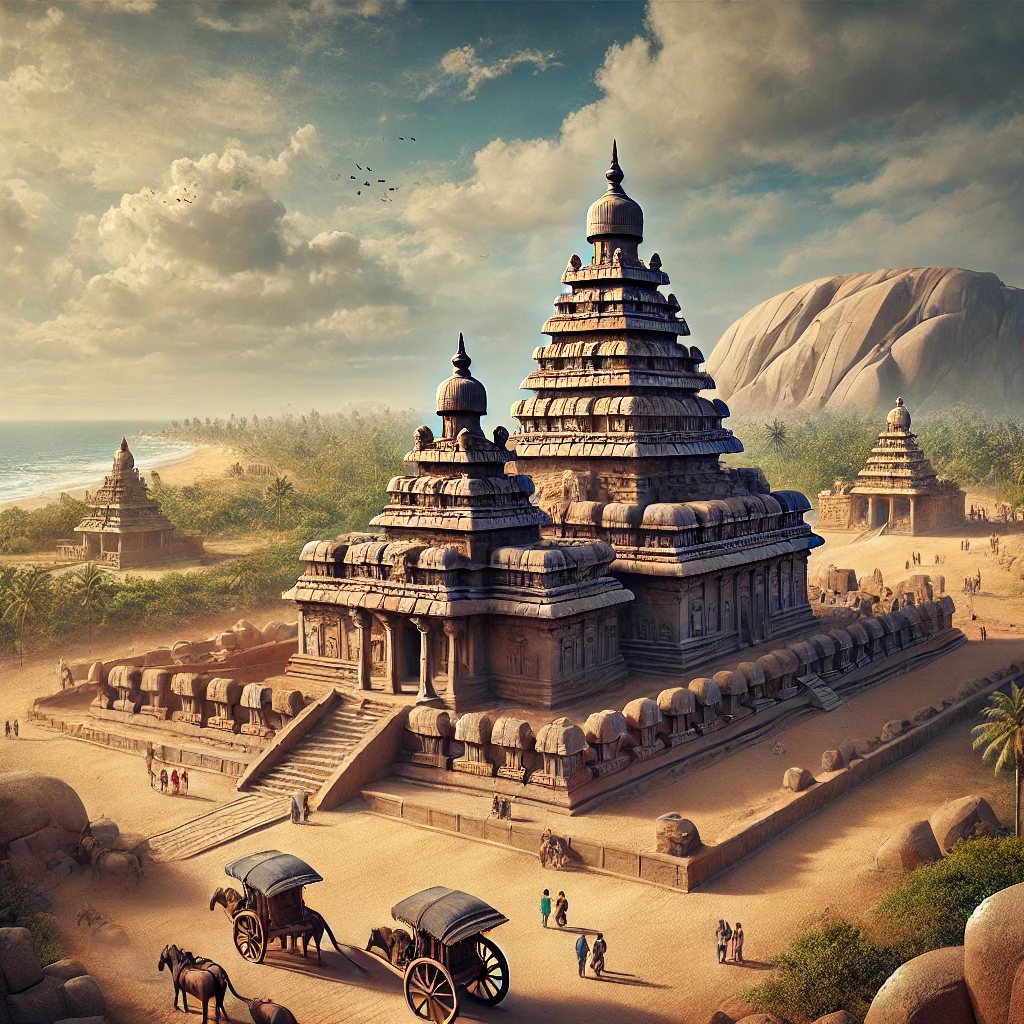
The Group of Monuments at Mahabalipuram in Tamil Nadu, India, is a collection of exquisite rock-cut temples and sculptures dating back to the 7th and 8th centuries. Built during the Pallava dynasty, these monuments reflect the architectural and artistic brilliance of ancient India. Recognized as a UNESCO World Heritage Site, Mahabalipuram attracts historians, architects, and travelers eager to witness its breathtaking stone carvings and monolithic structures.
History of Mahabalipuram Monuments
- Built in the 7th-8th century CE under the rule of Pallava kings, primarily Narasimhavarman I (Mamalla).
- A major center for maritime trade and Hindu religious architecture.
- The structures depict stories from Hindu epics like the Mahabharata.
- The name ‘Mahabalipuram’ is believed to be derived from King Bali, an asura (demon king) in Hindu mythology.
- Survived centuries of natural erosion, sea exposure, and invasions.
Architectural Wonders of Mahabalipuram
Mahabalipuram is home to rock-cut temples, cave sanctuaries, and monolithic sculptures, which showcase Pallava architecture.
| Monument Name | Type | Highlights |
|---|---|---|
| Shore Temple | Structural Temple | Overlooks the Bay of Bengal, one of the oldest stone temples in South India. |
| Pancha Rathas | Monolithic Rock-Cut Temples | Five chariots carved from a single rock, dedicated to the Pandavas. |
| Arjuna’s Penance | Rock Relief | A massive bas-relief carving depicting scenes from Mahabharata. |
| Krishna’s Butter Ball | Balancing Rock | A giant granite boulder precariously balanced on a slope. |
| Varaha Cave Temple | Cave Temple | Dedicated to Lord Vishnu in his Varaha (boar) incarnation. |
| Tiger Cave | Carved Shrine | Named after tiger-shaped carvings on its entrance. |
Why Visit Mahabalipuram?
- Historical Significance – One of the finest representations of Dravidian architecture.
- Artistic Grandeur – Intricate carvings showcasing epic tales and Pallava craftsmanship.
- Coastal Beauty – The Shore Temple’s stunning ocean backdrop makes for a mesmerizing sight.
- Adventure & Exploration – Ideal for history lovers, photographers, and explorers.
- Mahabalipuram Dance Festival – An annual cultural event featuring classical dance performances.
Best Time to Visit Mahabalipuram
The best time to visit is November to February, when the weather is cool and perfect for exploration.
How to Reach Mahabalipuram
| Mode of Transport | Details |
| By Air | Chennai International Airport (58 km away) is the nearest airport. |
| By Train | Chengalpattu Railway Station (30 km away) is the closest railway hub. |
| By Road | Well-connected via the East Coast Road (ECR) from Chennai and Pondicherry. |
Entry Fee & Timings
- Entry Fee: ₹40 for Indians, ₹600 for foreign nationals, Free for children below 15 years.
- Timings: Open daily from 6:00 AM to 6:00 PM.
Frequently Asked Questions (FAQs)
1. Why is Mahabalipuram famous?
Mahabalipuram is famous for its rock-cut temples, intricate sculptures, and historical significance as a thriving port city of the Pallavas.
2. What is the best time to visit Mahabalipuram?
The ideal time to visit is November to February, as the weather is pleasant.
3. How many monuments are in Mahabalipuram?
The site features over 40 ancient monuments, including temples, cave sanctuaries, and bas-relief sculptures.
4. Can visitors enter the Shore Temple?
Yes, visitors can explore the temple complex but cannot enter the sanctum sanctorum.
5. What are some nearby attractions?
- Crocodile Bank – A reptile zoo with rare species of crocodiles (14 km away).
- DakshinaChitra – A heritage village showcasing South Indian culture (25 km away).
- Covelong Beach – A scenic beach with water sports (18 km away).
Conclusion
Mahabalipuram is a treasured gem of South Indian heritage, offering a glimpse into the Pallava dynasty’s artistic and architectural excellence. Whether you’re a history enthusiast, spiritual seeker, or travel lover, this UNESCO-listed site is a must-visit. Plan your trip and experience the wonders of this ancient marvel!
